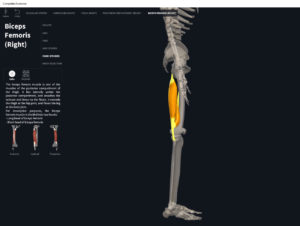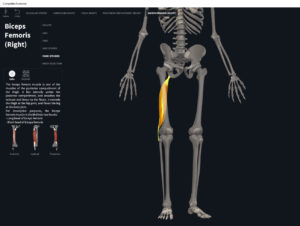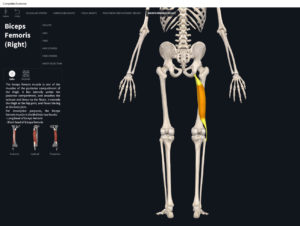Anatomy & Physiology: Muscles—Biceps Femoris, Long Head.
Structure.
- Long Head
- Origin: ischial tuberosity of the pelvis, part of the sacrotuberous ligament.
- Insertion: head of the fibula; lateral condyle of tibia.
- Short Head
- Origin: lower 1/3 of the posterior aspect (linea aspera) of the femur.
- Insertion: head of the fibula; lateral condyle of tibia.
Function.
- Concentric action: Long head—accelerate knee flexion, hip extension, and tibial external/lateral rotation. Short head— accelerate knee flexion and tibial external rotation.
- Reverse mover action: contralateral rotation, ipsilateral elevation, and posteior tilt of pelvis. Thigh flexion, medial rotation.
- Eccentric action: Long head—decelerates knee extension, hip flexion, and tibial internal/medial rotation. Short head— accelerate knee flexion and tibial external rotation.
- Isometric action: stabilization of lumbo-pelvic hip complex and knee.
- Innervation: tibial nerve from sciatic.
- Arterial supply: Long head—inferior gluteal artery, perforating branches of deep femoral artery, obturator artery. Short head—perforating branches of deep femoral artery, popliteal artery.
Clinical Significance.
More.
- https://www.anatomynext.com/biceps-femoris/
- https://www.youtube.com/watch?v=zSby5sZDOSw
- https://www.youtube.com/watch?v=PMiJ_7D15mA
- https://www.youtube.com/watch?v=MDpJTjZ1L2o
- https://www.youtube.com/watch?v=zvCZMo-hjec
References
Biel, A. (2015). Trail guide to the body: A hands-on guide to locating muscles, bones and more.
Clark, M., Lucett, S., Sutton, B. G., & National Academy of Sports Medicine. (2014). NASM essentials of corrective exercise training. Burlington, MA: Jones & Bartlett Learning.
Jenkins, G., & Tortora, G. J. (2012). Anatomy and Physiology: From Science to Life, 3rd Edition International Stu. John Wiley & Sons.
Muscolino, J. E. (2017). The muscular system manual: The skeletal muscles of the human body.




